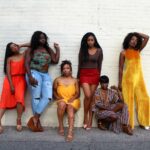Introduction to fashion icons
Fashion is a powerful form of expression. It tells stories, evokes emotions, and reflects the cultural zeitgeist of each era. Throughout history, certain individuals have transcended their time to become true fashion icons. These visionaries not only shaped the styles of their day but also laid the groundwork for modern trends we see today.
From glamorous Hollywood actresses to revolutionary designers, these figures have inspired countless wardrobes and influenced how we perceive beauty and style. Join us as we journey through the decades and explore some of these iconic personalities who continue to inspire our fashion choices in vibrant ways.
Fashion is a powerful form of expression. It tells stories, reflects societal changes, and showcases personal identities. Throughout history, certain individuals have stood out as style icons who transformed the fashion landscape. From Hollywood glamour to streetwear chic, these trendsetters have left an indelible mark on our wardrobes.
But what makes someone a fashion icon? Is it their unique sense of style, or perhaps their ability to challenge norms? In every decade, there are figures whose influence resonates far beyond their time. They inspire designers and shape trends that continue to evolve today.
Coco Chanel and the Flapper Style
Coco Chanel revolutionized women’s fashion in the early 20th century. With her daring vision, she introduced the flapper style—a look that embraced freedom and femininity.
Chanel’s designs stripped away the constraints of corsets, allowing women to move with grace. The iconic little black dress emerged from this period, symbolizing sophistication and versatility.
Flappers were known for their boldness. They danced through life in dropped-waist dresses adorned with fringe and beads. Chanel’s influence extended beyond clothing; she epitomized a lifestyle characterized by confidence.
Her penchant for simplicity combined with elegance set a new standard in fashion. Women began to embrace comfort without sacrificing style. This shift paved the way for future generations to express themselves freely through their wardrobe choices.
Chanel not only changed how women dressed but also how they viewed themselves—empowered and unconfined by traditional norms.
Audrey Hepburn and the Classic Elegance
Audrey Hepburn embodies timeless elegance. Her style continues to inspire and captivate fashion lovers around the globe.
Known for her iconic little black dress in “Breakfast at Tiffany’s,” she set a standard that transcends generations. The simplicity of her outfits paired with exquisite tailoring defines classic chic.
Hepburn favored clean lines and minimalist accessories, allowing her natural beauty to shine through. She often wore ballet flats, which represented both comfort and sophistication—a perfect combination even today.
Her influence reaches beyond clothing; it extends into how women perceive grace and poise. Audrey’s ability to blend femininity with strength had a profound impact on women’s fashion in the 20th century.
Her legacy endures not just in garments but also in the way we celebrate individuality through style. It’s this lasting impact that keeps her spirit alive in contemporary wardrobes everywhere.
Diana Ross and the Disco Influence
Diana Ross is synonymous with the disco era. Her vibrant presence transformed music and fashion in the 1970s. She radiated confidence, captivating audiences on and off the stage.
Ross’s style was bold and glamorous. Think sequins, flowing gowns, and dazzling accessories. Each outfit told a story of freedom and self-expression.
Her influence reached far beyond her songs. The iconic hairstyles—big, voluminous curls—became symbols of empowerment for women everywhere. They embraced their individuality through fashion choices inspired by Diana.
On dance floors across America, people emulated her looks while grooving to hits like “Ain’t No Mountain High Enough.” The energy she brought to performances ignited a movement.
Today’s designers still draw from that disco aesthetic. Elements of glittering fabrics and dramatic silhouettes remain ever-present in modern collections inspired by Ross’s unforgettable legacy.
Kate Moss and the Grunge Look
Kate Moss emerged as a defining figure of the 90s grunge aesthetic. Her effortless style resonated with a generation that craved authenticity over polish.
With her waifish frame and edgy attitude, she became the face of designers who embraced this raw look. Think oversized flannel shirts, distressed jeans, and combat boots paired with delicate lace slips.
Moss didn’t just wear clothes; she embodied an entire movement. The juxtaposition of femininity and rebellion made her influence profound. She showed how to mix high fashion with streetwear effortlessly.
Models like Moss taught us that looking “put together” could also mean embracing the messy side of life. Her impact is still felt today in modern wardrobes filled with vintage finds and laid-back pieces.
The spirit of grunge continues to inspire countless fashionistas who seek comfort without sacrificing style.
Sarah Jessica Parker and the Power of High Fashion
Sarah Jessica Parker redefined fashion in the early 2000s. As Carrie Bradshaw on “Sex and the City,” she became a symbol of chic, daring style. Her character showcased an eclectic mix of high-end designers and vintage finds.
Parker’s bold choices inspired women to experiment with their wardrobes. She wasn’t afraid to pair a luxurious dress with quirky accessories. This fusion created a unique voice in fashion that resonates today.
Beyond the screen, her influence expanded into real life. Parker launched her own fashion lines, promoting accessible elegance for everyday wear. She emphasized individuality over conformity.
Her impact went beyond clothing; it was about confidence and self-expression. Even now, her iconic looks inspire countless trends on runways and sidewalks alike. Whether it’s towering heels or statement jewelry, Sarah Jessica Parker continues to shape how we view femininity in fashion.
Current fashion icons and their impact on today’s styles
Today’s fashion landscape is vibrant, shaped by a new generation of icons. Influencers like Billie Eilish and Timothée Chalamet challenge conventional norms with bold choices that emphasize individuality.
Eilish’s oversized silhouettes and neon hues resonate deeply with young audiences. She embodies the spirit of freedom in fashion, allowing self-expression to take center stage.
On the other hand, Timothée brings a fresh perspective to menswear. His daring approach combines classic tailoring with avant-garde pieces, proving that men can also embrace playful styles.
Rihanna continues to redefine beauty standards through her Fenty brand. Her commitment to inclusivity pushes brands toward diverse representation while celebrating all body types.
Zendaya stands out for her effortless blend of high-end glamour and street style versatility. She inspires fans by showcasing how clothing can empower one’s identity.
These contemporary figures are not just trendsetters; they are cultural shifts driving an inclusive future in fashion.
Conclusion
Fashion has always been a dynamic reflection of culture, society, and individual expression. The icons we explored have left indelible marks on the world of style. From Coco Chanel’s revolutionary designs that liberated women to Audrey Hepburn’s timeless elegance, each figure brought something unique.
Diana Ross made waves with her vibrant disco looks, while Kate Moss introduced an edgy grunge vibe that resonated with a new generation. Sarah Jessica Parker transformed high fashion into everyday wear, encouraging bold choices and personal flair.
Today’s fashion icons continue this legacy. They push boundaries and redefine norms in ways that inspire countless individuals around the globe. As trends evolve and styles shift, one thing remains clear: the influence of past fashion legends is felt strongly in today’s wardrobes.
The cycle of inspiration never ends—each decade brings forth new talents who pay homage to those before them while crafting their own identities within the ever-changing landscape of fashion.


